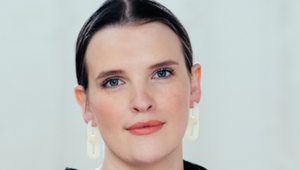
‘Mid-Tier Production Is Disappearing’: Kat Garelli on a Polarised, Precarious Market

'Money Talks' is an interview series, created in partnership between Little Black Book and SYZYGY, that’s been busting taboos by shining a light on the role of finance in production.
We’re speaking to leading producers and production company owners about the financial pressures they face day-to-day, and what challenges they need to overcome in order to simply make top-tier productions happen. Over the course of these conversations, we hear first-hand stories from the production frontline and get a little more comfortable talking about that most important of topics: money.
Up today is Kat Garelli, executive producer and head of production at World War Seven, who addresses the systemic issues that continue to put production businesses at risk: contradictory contract expectations, shrinking markups, and a disappearing middle tier of work. Kat unpacks the challenges independent production companies face just to stay afloat – let alone thrive – but shares why WW7’s people-first approach is core to its long-term resilience.
She chats with LBB’s Addison Capper.
NB: Hit the links to check out the other parts of the series with PRETTYBIRD’s Ali Brown, Knucklehead’s Tim Katz, Love Song’s Kelly Bayett, and hungryman’s Caleb Dewart.
LBB> Something we often hear is that timely payments can be a tricky factor in production. There's a contradiction between the need to obey contract dates when it comes to the shoot but the terms of payment seem a bit more 'flexible'. What are your thoughts on this?
Kat> Mutual honour of contract terms is one of the great contradictions in our industry. On the production end, we’re expected – and contractually bound – to meet every milestone on time for a project. We take that responsibility seriously, not only because of our commitment to each project, but also because of our obligation and desire to provide excellent service to our agency and client partners.
We’re expected to front significant costs during production – labour, equipment, locations – often well before we receive remittance advice from agencies, let alone any funds in-house. It puts production companies at the precipice of financial risk, especially as budgets shrink and margins tighten. As producers, we understand things happen – sometimes we need to start prep immediately on time-sensitive projects while funds are held up by the financial restrictions of mega-corporations.
But production companies going out of pocket and floating the budgets for massive corporate clients due to contractual sequential liability should be the exception, not the unspoken expectation. Timely payments aren’t just about reciprocity – they’re about sustainability for the independently owned, often small production companies who bring clients’ campaigns to life.
LBB> There's also the costs that go into bids and treatments, which can impact companies of all sizes. Is this still an issue do you feel, and what is the current status of this part of the production process? Can it ever be changed/adapted?
Kat> Sunken pitch costs have always been and will always be an issue for production companies, given the longstanding precedent that working on treatments and bids is essentially unpaid development work done by production companies on behalf of agencies and clients. It is not at all unusual that a single director treatment could cost upwards of $5,000 in freelance labour, and subscriptions for research and assembly platforms. In a landscape where a simple pitch deck with stills and a written approach is no longer enough, directors now routinely provide full storyboards, concept art, or even animatics for free during the pitch phase, without any guarantee their ideas won’t be lifted and handed to another director who wins the job.
There are ways to mitigate this cost, such as retaining treatment designers and writers on salary, as opposed to paying day rates for freelancers on a per-project basis. However, depending on board flow, treatment staffers are often spread thin on upwards of three to five pitches at a time, which makes the quality of each pitch suffer, and thus hurts the chances of winning each job. Or on the opposite end, in slow periods where there aren’t a ton of active pitches or jobs, we’re not making production fees to support the overhead of full-time treatment staffers.
The production landscape must continue the demand that agencies and clients remunerate companies and their directors for their work on pitches, citing other international production hubs such as France, Germany, and Scandinavia as successful models – especially as treatments grow into full-blown pre-production books with boards. This is especially pertinent for companies that choose to engage in triple bids against an agency’s in-house production arm, which almost always win the job. Even if the claim rings out into an empty void, as it has for decades now, we should continue to remind agencies and clients that this problem is never going away, and an alternative, fair, equitable solution is possible: agencies or clients cover pitch costs any time the bid is competitive (and not single source).
"Production companies going out of pocket and floating the budgets for massive corporate clients due to contractual sequential liability should be the exception, not the unspoken expectation."
LBB> Talk to me about 'markup', and how it impacts the financial health of a production company. Is there truth in that or more of a myth? Why?
Kat> I’d love to pick the brain of anyone who’d say that is a myth! ‘Markup’ is the primary way a production company makes its money, especially in a time when each bid is thoroughly reviewed by production cost consultants. These consultants cross-compare the market rates for each line item across competing production companies and encourage everyone to match the lowest bidder, thus eliminating any sort of profit margin or pad in the lines of a budget.
There’s also an ever-growing trend where production companies will lower their markup percentage in order to hit a budget and secure a job, thus setting the dangerous precedent that production companies can survive on smaller and smaller production fees, despite growing overhead costs. Whereas a 25% production fee used to be standard (I hear tell it used to be closer to 30%, but that’s before my time), I frequently hear of companies bidding their markup around 15% for the last few years as a means to satisfy agencies’ shrinking budgets and compete with production companies undercutting one another. In that sense, the way markup is regarded feels like a race to the bottom, and sets a dangerous precedent for how much it actually costs to run a production company in today’s industry.
The truth is that at most production companies, and certainly at ours, the production fee on jobs isn’t some nebulous company fee going into the profit void. It’s the money that keeps us – EPs, producers, bidders, coordinators, treatment teams, office staff, sales reps, and ultimately our freelance crews – employed and able to continue generating work.
"The way markup is regarded feels like a race to the bottom, and sets a dangerous precedent for how much it actually costs to run a production company in today’s industry."
LBB> PSAs can be great opportunities to be more creative and flexible in approach, and they can also gain great traction. But, they're often done for free! How do you feel about that tension?
Kat> It’s getting increasingly difficult to produce PSAs because the favours we once called in with crew and vendors for these projects are now needed for paid work for for-profit corporations, not 501C3 organisations. Slashed production budgets mean we’re using up those goodwill reserves on low-budget commercial jobs that used to fund passion projects, specs, or PSAs.
While it’s true PSAs are for great causes and sometimes afford more creative flexibility for directors than paid brand work that must hit brand messaging mandates and testing results, it’s difficult to dedicate a production solely to them, especially when the production company is footing the bill. I find it easiest to produce them if we’re tacking the production onto an existing shoot – which needs to be expressly declared to clients for any conflicts of interest and can often get shut down – or if the PSA production is done over a number of months, spreading the resource needs out across multiple projects.
Regardless of how they are made, the PSA landscape is shrinking because production companies are essentially being asked to work for free to produce them or, often, to invest in them on behalf of clients.
LBB> When it comes to budgeting a production, what’s the most surprising thing that you need to account for?
Kat> The most surprising line item we’ve had to account for in domestic productions increasingly is the cost associated with implementing sustainable and environmentally responsible practices. Due to the short lived nature of all our productions, it’s always shocking just how much waste we generate, between the food waste for catering a crew of 150 people, to sets that are built only to be thrown out days later, to the fleets of vehicles burning gas for days at a time. While the industry broadly recognises the value of eco-conscious production, the infrastructure to support it domestically often comes at a premium. Basic measures like reusable water bottles, catering service items, EV fleets, and waste management typically require dedicated eco-coordinators, third-party vendors, and added fees in the US.
By contrast, in many international markets – Mexico being a notable example – these practices are culturally and operationally embedded into the production model at no extra cost. Catering, for instance, routinely utilises reusable containers and cutlery as a baseline expectation, not a billable upgrade. The disparity underscores how sustainability, while globally endorsed, varies dramatically in implementation and cost by market.
Unless a client has formally committed to a sustainability programme like Green the Bid, they generally expect production to absorb these costs rather than bid for them. As a result, the not-insignificant price of being eco-friendly often eats into the budget meant for what actually goes in front of the camera. It’s a quiet irony that doing the ‘right thing’ can be more expensive in the very market that claims leadership in sustainable storytelling.
"Slashed production budgets mean we’re using up those goodwill reserves on low-budget commercial jobs that used to fund passion projects, specs, or PSAs."
LBB> Broadly speaking, how healthy do you think the financial landscape of the industry is right now?
Kat> The industry’s financial landscape is increasingly precarious, marked by a sharp and growing polarisation that threatens the long-term viability of its mid-tier core. The so-called ‘middle class’ of production – the bread and butter of our business, typified a decade ago by the $250-400,000 per-day shoot costs – is vanishing. We’re now seeing a polarised market: on one end, marquee $2 million-plus campaigns, dominated by a small pool of elite directors and production companies, often starring celeb talent; on the other, an explosion of underfunded $150–250,000 shoots, usually expected to yield the same volume and polish of deliverables, despite being operationally untenable without severe crew or resource cuts.
Perhaps most concerning is this homogenisation of client and agency expectations across budget tiers. Regardless of whether a project is resourced at $2 million or $200,000, the scope of deliverables, speed of execution, and standards of creative output remain largely indistinguishable.
LBB> For any production business-owners reading this interview, what’s the best piece of advice you’ve either been given or had to learn first-hand?
Kat> The best advice I’ve gotten wasn’t from a colleague in production, but from my father, a small business owner himself. He owned a local diner in a coastal New Jersey town for 45 years until it was destroyed by a hurricane. For him, the restaurant was less of a business and more of a meeting point for the community. His whole mantra was repeat business – he firmly believed that if you treat your employees and customers right, and give them a great experience, that they’ll keep coming back for more. I adopted that belief in how I handled client management early on, and was fortunate to find partners at WW7 who had the same exact philosophy. It’s all about the long game – we’re not a volume shop in it for a quick buck, but to develop sustained relationships that will pay dividends over time. It’s hard to forget in an industry quite literally predicated on fast-paced, high-churn productions, but it’s led to the most rewarding partnerships in my career to date.
"The industry’s financial landscape is increasingly precarious, marked by a sharp and growing polarisation that threatens the long-term viability of its mid-tier core."
LBB> Finally, how do you ensure that you have enough available money for developing talent within your company, and funding passion projects such as short films and music videos?
Kat> Simply put, there’s no way to ensure it. If we believe in a rising talent, we are not afraid to invest in them out of pocket. We make a real point of keeping our overhead low for this exact reason. Our staff is lean, our roster is tight, and we still operate fully remote / WFH post-covid, which helps us stay efficient and frees up resources to support emerging talent and passion projects.
We’re constantly weighing the importance of these things – going back to having an office, or hiring additional new staffers – against the benefit of allocating those funds to developing emerging talent instead, which is really what it’s all about, isn’t it? At the end of the day, our business is in representing talent that we support, believe in, and want to invest in, so the decision is always easy. We value our people over profits, and that’s not just a tagline.
To see more from LBB and Syzygy's Money Talks series, click here.












